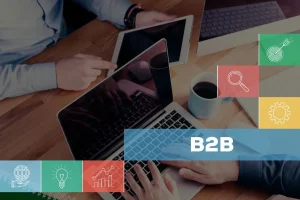Understanding the differences between lead generation and appointment setting is integral in sales and marketing. Lead generation entails gathering contact details from individuals or businesses who express an interest in your product or service, while appointment setting involves engaging these potential customers, perhaps leading them to purchase your products later on.
Lead generation centres on collecting contacts, while appointment setting moves prospects closer toward purchase. We will explore each aspect’s goals, strategies, processes, and impact. This article will help businesses more efficiently use appointment-setting services and B2B lead generation services from the best appointment-setting agencies to boost sales.
Goal
Lead generation aims to draw attention to your business by discovering potential clients who might be interested in what you offer by making them do things like filling out contact forms or subscribing to newsletters.
Appointment setting has different aims: it identifies which leads are genuinely interested in buying before booking meetings with these prospective buyers and handing them off to sales teams as prospects. Appointment setting does come after lead generation, so you can do lead generation without appointment setting, but you can’t do appointment setting without lead generation.

Strategy
Appointment setting and lead generation both aim to connect with prospective clients and increase sales, but their strategies vary significantly. Appointment setting involves scheduling an appointment time with a prospect to try to close a deal; lead generation involves gathering potential client information that is then passed onto sales teams or specialised appointment setters, who then evaluate its worthiness as leads. Both methods work hand-in-hand, but each has its own distinct way of engaging prospective customers.
Process
The process of lead generation involves advertising to your target audience to get their contact information. Whether they share their details depends on how good your marketing strategy is. The outcome can vary, as not everyone will respond, reflecting differences between cold, warm, and hot leads.
The appointment setting is more straightforward; you choose qualified leads to set appointments. Once an appointment is set, your sales team makes the scheduled call, and a decision about the purchase is made. This clear and direct process helps move prospects closer to becoming customers.
Influence
Both lead generation and appointment setting have their own effects on your target audience. Lead generation involves building up a larger pool of potential clients for you to work with and creating a bigger sales pipeline; appointment setting focuses on forging stronger connections between leads already present in your pipeline and new leads that come through your sales pipeline. Simply put, lead generation provides a long-term solution by increasing audience size, while appointment setting provides a short-term solution by increasing conversion rates.
Implementation
Implementing lead generation involves creating appealing advertisements and content to draw in potential clients, including social media posts, email campaigns, or online ads that capture contact details.
Appointment setting requires more hands-on involvement from businesses. It involves reaching out to generated leads, assessing their interest, and scheduling a time for your sales team to connect with them directly. By employing both approaches together, businesses can expand their audience while turning interested leads into loyal customers.
How Does the Appointment Generation Work?
A good appointment-setting process is tailored to the industry and the specific company. Here’s a typical process for a B2B organisation, along with some best practices.
Work closely with your marketing team to define an ICP (Ideal Customer Profile). Use market research and corporate self-examination as tools for finding companies and decision-makers who fit that ICP, then design multifaceted campaigns targeting them directly.
Begin by compiling a prospect list consisting of both organisations and individuals interested in your offerings, prioritising warm leads from your marketing strategy that have demonstrated some enthusiasm about what you offer.
As Will Rogers once said, ” a first impression lasts only once,” so create your initial message carefully, whether it’s salesy, consultative, conversational, formal, or informal.
Qualifying leads should feel natural. Appointment setters need to know and understand each potential lead’s ICP as well as any flexibility available for each lead they evaluate.
Once the lead is qualified, naturally extend the conversation and ask, “When would be a good time to discuss what our company can do for you in greater detail?” This is how you set the appointment.
After the prospect agrees to the appointment, confirm it using a teleconferencing platform. Ensure both the prospect and the closer (the sales rep) are on the same page. Confirming the appointment while still on the call helps ensure it’s scheduled and remembered.
The appointment setter should email the closer a written debrief within minutes of scheduling the appointment. A follow-up meeting can discuss additional questions and share impressions.
Good appointment-setting teams follow up with reminders about the upcoming meeting. This keeps the appointment in the prospect’s mind without overwhelming them with emails.
Track metrics like conversions (appointments scheduled) and show rates (how many people attend the appointments). Measuring and analysing these metrics helps determine if your approach is working or needs adjustments.
A feedback loop allows the team to discuss performance, create plans based on facts, and align strategies for success. Regularly reviewing and improving the process ensures continued effectiveness.
Impact of Appointment Setting on Business
Appointment setting is more than simply filling your calendar; it’s about expanding your sales pipeline and driving business growth through qualified leads. If done right, appointment setting can have a significant impact on various aspects of your company.
Appointment setting increases revenue in several ways. More appointments mean more chances to sell products or services, leading to higher income. By continually feeding qualified leads into your sales pipeline, sales teams gain additional chances to close deals and transform interested prospects into paying customers.
Appointment setting increases efficiency. A well-organised process (one of the benefits of sales training) enables your sales team to concentrate on selling instead of the time-consuming task of finding quality leads; this approach ensures they focus on connecting with those most likely to buy, making the sales process more effective and less time consuming.
Enhancing customer relationships is also of vital importance. A salesperson’s daily activities include relationship-building to create lasting business connections by making the meeting worthwhile and offering something valuable during it.
Appointment setting serves as the backbone of your sales strategy, fuelling both your pipeline and team with qualified leads to make conversion easier, thus creating a healthy sales environment with steady leads flowing in your sales funnel.
Time efficiency is another significant advantage of appointment setting. Time is money in sales, so making sure your sales reps only spend their time meeting qualified leads is time well-spent and allows your team to focus on selling what it knows how.




